Abstract
In this study, the catalytic air oxidation method was used to selectively form sodium antimonate from an antimony residue Na2S-NaOH leaching solution of a high arsenic copper anode slime. In the first stage, the leaching process with Na2S and NaOH media resulted in more than 98% leaching of antimony. The synergistic oxidation method was used to selectively separate antimony in the second stage. In this study, the oxidation rate of antimony was greater than 98% at the NaOH concentration of 50 g·L−1 and a combined oxidation concentration of 0.75 g·L−1 catechol + 0.75 g·L−1 KMnO4, under the air flow rates of 1.415 m3·min−1 at 75 °C for 8 h. The pH of the crude sodium antimonate product was adjusted; subsequently, it was redissolved and precipitated to prepare refined sodium antimonate that meets the secondary product standard of China’s non-ferrous metal industry, which recommends an antimony recovery rate of >95.60%. After neutralisation, the liquid contains [As] < 0.10 g·L−1, [Sb] = 0.16–0.38 g·L−1, which can be reused in the composite leaching process. The apparent activation energy (Ea) of the catalytic oxidation reaction was 6.47 kJ·mol−1; the results suggested that the reaction process was diffusion controlled. .
1. Introduction
Sodium antimonate is widely used in medicine, chemical industry, electronics, and other industries as a clarifying agent, decolorising agent, and flame retardant owing to its special physical and chemical properties []. Sodium antimonate can be prepared using pyrometallurgical and hydrometallurgical processes. The pyrometallurgical process [] mainly uses metal antimony or antimony oxide as raw materials. Sodium antimonate products have been prepared by reacting sodium nitrate with antimony oxide under alkaline and high-temperature conditions, followed by washing, filtering, drying the product. Although the process is simple, it has certain disadvantages including high raw material requirements, low product purity, high energy consumption, and production of harmful gas such as NOx (x = 1 or 2) during the process. Thus, this process has not been extensively used. Sodium antimonate has been prepared by using antimony minerals or smelting intermediate materials as raw materials under acidic or alkaline conditions, followed by the addition of oxidants for leaching, purification, filtration, and other processes [].
Oxidative leaching has been carried out in an acidic system, using HCl as a leaching agent, and Cl2 and H2O2 as oxidants [,]. The leaching solution uses ethylenediaminetetraacetic acid (EDTA) or potassium ferrocyanide [] to remove impurities and adjust pH to hydrolyse antimony and obtain HSbO3 or SbOCl. Moreover, sodium antimonate has been prepared via alkali treatment or through the direct addition of NaOH, which hydrolyses Sb5+ [,]. Despite the advantages of this process such as strong adaptability to raw materials and high product purity, there are certain disadvantages including requirement of harsh operation conditions, considerable equipment corrosion, and significant wastewater generation, making it less susceptible. The alkaline system is leached in NaOH [,], KOH [,], and other systems, and uses air, H2O2, and other oxidants [,] for oxidation in order to prepare sodium antimonate. The process is short, and the operation is simple; however, the NaOH and KOH systems must be subjected to precipitation reconstitution owing to the high cost involved in the use of KOH and H2O2. Na2S and the Na2S-NaOH system [,] leach antimony to form sodium thioantimonite; subsequently, sodium antimonate is prepared via atmospheric air oxidation [,], high pressure oxidation [], or catalytic oxidation [,]. After oxidation, S exists in the form of sodium thiosulfate in the solution, and the sodium thiosulfate by-product is obtained through neutralisation, impurity removal, concentration, and crystallisation. This simple process is widely used because of its high product purity, high yield, and low cost. Although many studies have reported the preparation of sodium antimonate using the Na2S-NaOH system, the research mainly focuses on the optimisation of leaching or oxidation process. The kinetics of the process, especially the kinetics of the oxidation process, are not extensively studied, and the key control parameters are not clear [].
In the present study, the high arsenic antimony residue is achieved by composite leaching of a copper anode slime (sulfuric acid + hydrochloric acid + sodium chloride), followed by adjustment of the pH of the leaching solution and precipitation of antimony. For this material, the research group used the Na2S-NaOH system to conduct leaching research in the early stage, and antimony was successfully leached into the solution []. The selective and efficient recovery of antimony allows the preparation of sodium antimonate products that meet the standards of the non-ferrous metal industry. Additionally, the kinetics of the catalytic oxidation process is studied to clarify the reaction mechanism underlying the selective separation of antimony, and obtain the restrictive link, which is significant for industrial production. The process flow chart is shown in Figure 1.
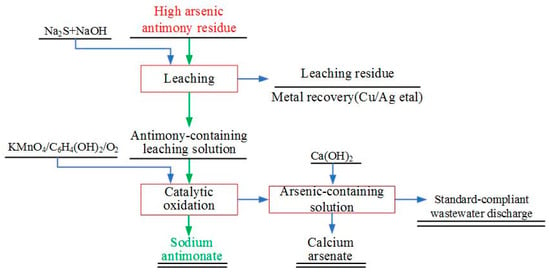
Figure 1.
Process flow chart of high arsenic antimony residue.
2. Material and Methods
2.1. Materials
The high arsenic antimony residue was obtained from Jiangxi Copper Corporation Guixi Smelter (Yingtan, China) in southern China and was used in the experiments.
2.2. Experimental Principle
The high arsenic antimony residue mainly exists in the form of SbOCl. The first compound leaching process using Na2S + NaOH is employed, where antimony is leached into the solution in the form of SbS33−. Copper/silver and other precious metals are retained in the leach residue. The reaction equation is
Sb4O5Cl2 + 12Na2S + 5H2O = 4Na3SbS3 + 10NaOH + 2NaCl.
Antimony and arsenic exist as SbS33− and AsS33− ions in the leaching solution, respectively, under alkaline conditions. Their oxidation results in the formation of SbO43−, AsO43−, and S2O32− species under alkaline conditions. The reaction is as follows:
2Na3SbS3 + 2NaOH + 7O2 + 5H2O = 2NaSb(OH)6↓ + 3Na2S2O3,
2Na3AsS3 + 6NaOH + 7O2 = 2Na3AsO4 + 3Na2S2O3 + 3H2O,
2Na2S + 2O2 + H2O = Na2S2O3 + 2NaOH.
On oxidising the leaching solution, NaSb(OH)6 precipitates, while Na3AsO4 dissolves in water to separate and remove the impurities. The arsenic-containing solution forms calcium arsenate precipitate after liming precipitation, and the treated wastewater is discharged after meeting the standard.
2.3. Experimental Method
2.3.1. First Compound Leaching
The leaching experiments of the antimony-enriched high arsenic copper anode slime were conducted in 250 mL round-bottom flasks. The reaction solution was prepared according to a certain ratio of Na2S and NaOH, and the antimony-enriched high arsenic copper anode slime was added to the above reaction mixture at a certain liquid-to-solid (L/S) ratio. The temperature was set and controlled using a water bath (DF-101S, Gongyi Yuhua Instrument Co., Gongyi, China).
First, the leaching experiments were conducted to study the influence of the leaching temperature (45–95 °C), Na2S concentration (90–180 g/L), NaOH concentration (15–70 g/L), leaching time (0.5–3 h), and L/S ratios (3–7 mL/g). After a predetermined duration, the resultant slurry was filtered. The filtrate and washing solutions were subsequently subjected to chemical analysis to calculate the leaching efficiency.
2.3.2. Synergistic Oxidation
After the temperature rises to a certain value, add a certain amount of oxidation to the leachate solution; oxygen is flowed at a certain flow rate over this solution to carry out the reaction. The concentration of antimony in the filtrate, obtained after the completion of the reaction, was determined by the cerium sulphate titration method []. The oxidation efficiency of antimony ω (%), was calculated using Equation (5):
where C0 is the antimony concentration in the leaching solution (g·L−1), and C1 is the antimony concentration in the oxidised liquid (g·L−1).
2.3.3. Kinetics Analysis
The oxidation efficiency of antimony was obtained by controlling different reaction temperatures (55–85 °C) and times (0–3 h) under the reaction conditions of a certain oxidation concentration (KMnO4 concentration of 0.75 g·L−1, catechol concentration of 0.75 g·L−1), air flow rate (1.415 m3·min−1), and NaOH concentration (250 and 300 g·L−1). The kinetic results and apparent activation energy of the catalytic oxidation process were obtained using the half-life and isolated method.
2.4. Analytical Methods
2.4.1. Solid Material Analysis
The chemical composition of each element in high arsenic antimony residue, leaching residues, and precipitation products was analysed by X-ray fluorescence spectrometer (Magix pw2424, PANalytical B.V., Almelo, The Netherlands) determine the phases in the slag and chemical analysis determine the content of relevant elements. The main mineral phases present within the samples were identified by a Rigaku-TTRIII X-ray diffractometer (Cu target, Kα1, λ = 0.154 nm) (Tokyo, Japan), while the microstructure and phase compositions were ascertained via scanning electron microscopy (SEM, MIRA 3 LMH type from TESCAN Brno, S.r.o, Brno, Czech Republic).
2.4.2. Solution Analysis
The high arsenic antimony residue was dissolved by chemical dissolution method and low concentration solution. Its composition was determined by inductively coupled plasma-atomic emission spectrometry (ICP-AES, Thermo Electron IRIS Intrepid II XSP, Waltham, MA, USA) quantitative analysis. High-concentration antimony solution using cerium sulphate titration method to determine the concentration of antimony in solution.
The cerium sulphate titration method conducted to measure the concentration of antimony [] was as follows: 1~5 mL of leaching solution was measured in a 250 mL conical flask; potassium sulphate (2 g) and hydrazine sulphate (0.2 g) were added to this solution, followed by the addition of a small amount of water. Next, 20 mL sulfuric acid was added to the above reaction mixture, which was heated for 0.5 h to obtain a clear solution. After complete dissolution, the reaction mixture was cooled to room temperature followed by the addition of 100 mL of water. The resultant reaction mixture was boiled for 5 min, followed by the addition of 20 mL of hydrochloric acid and 2–3 drops of 0.1% methyl orange indicator. This mixture was immediately titrated with Ce(SO4)2 standard solution until the red colour disappeared at the end point. At the same time, a blank test was carried out.
The concentration of antimony can be calculated using Equation (6):
where C is the concentration of the standard solution of cerium sulphate (mol·L−1), V is the volume of the liquid to be tested (mL), V1 is the volume of the standard solution of cerium sulphate consumed by the sample solution during titration (mL), V0 is the volume of standard solution of cerium sulphate consumed by the blank solution during titration (mL).
3. Results and Discussion
3.1. Characterisation of High Arsenic Antimony Residue
Table 1 shows elemental composition of the slime; the content of antimony was the highest, with a value of 34.7%, indicating its high recovery value. However, the content of arsenic, copper, lead was found to be 7.47%, 8.99%, and 1.61%, respectively(wt.%). Therefore, the material was difficult to handle.

Table 1.
Elemental composition of the high arsenic antimony residue.
Figure 2 shows the X-ray diffraction (XRD) pattern of the residue, which clearly indicates that the elements present in the slime material were relatively complex. Among the compounds detected, antimony mainly exists in the form of SbOCl and Sb4O5Cl2, while Cu mainly exists in the form of CuCl2 and Cu3(AsO4)2. Other elements were also found in the form of PbCl, PbSO4, BiOCl, AgCl, and other phases.
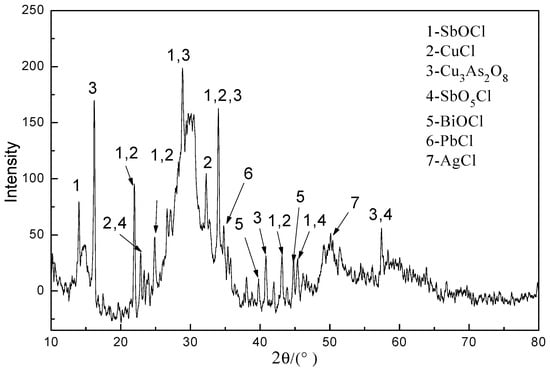
Figure 2.
XRD pattern of the high arsenic antimony residue.
3.2. Selective Separation of Antimony with Compound Leaching
Antimony was selectively separated through compound leaching under optimal reaction conditions at a reaction temperature of 85 °C, a Na2S concentration of 165 g·L−1, a NaOH concentration of 30 g·L−1, an L/S ratio of 5, and a leaching time of 1 h [], while the remaining metal elements were left in the slag for the formation of sodium antimonate. The composition of the residues before and after compound acid leaching and the leaching efficiencies of the metals are summarised in Table 2. The leaching efficiency of antimony was 94%, the antimony concentration of the leachate was 47.18 g·L−1, the arsenic concentration was 9.32 g·L−1, and the OH− and S2− concentrations were 11.40 and 2.67 g·L−1, respectively. Both copper, lead, silver, and bismuth less than 3%, respectively. Suggesting copper, lead, silver and bismuth enrichment of approximately 290%, 290%, 280%, and 270%, respectively. The compound leaching slag can be returned to the copper anode slime smelting system for further recovery.

Table 2.
Composition of the compound leaching slag and raw materials.
3.3. Preparation of Sodium Antimonate by Catalytic Oxidation
3.3.1. Effect of Type of Oxidation
Under conditions of sodium hydroxide concentration at 40 g·L−1, reaction temperature at 55 °C, and air flow rate at 0.708 m3·min−1, the reaction was conducted for 10 h to investigate the effect of different catalysts on the oxidation rate of antimony. The results are shown in Table 3.

Table 3.
Oxidation efficiency of antimony at the NaOH concentration of 40 g·L−1 and under the air flow rate of 0.708 m3·min−1 at 55 °C for 10 h in the presence of different types of oxidations.
The catalytic effect of phenol and catechol as a single oxidation was similar, but the oxidation efficiency was low. However, the effect of the composite oxidation was stronger than that of a single oxidation. The combined oxidation composed of catechol and KMnO4 exhibited the highest catalytic activity, while the effect of the combined oxidation composed of diphenol, KMnO4, and phenol was weaker than that composed of catechol and KMnO4. Therefore, the combination of catechol and KMnO4 was selected as the oxidation, and not phenol because it showed a negative effect and further reduced the catalytic effect.
Catechol is oxidised by potassium permanganate to form catechol quinone (C6H4O2), while potassium permanganate is reduced to manganese dioxide (MnO2), generating potassium hydroxide (KOH) and water (H2O). Additionally, hydroxyl radicals are released during the reaction. These hydroxyl radicals combine with oxygen, ultimately oxidising antimony from the Sb(III) to the Sb(V). The specific reaction equation is as follows:
3C6H4(OH)2 + 2KMnO4 = 2MnO2 + 2KOH + 2H2O + 3C6H4O2,
C6H4O2 + O2 = C6H4O2·O2,
2Na3SbS3 + 2NaOH + 7C6H4O2·O2 + 5H2O = 2NaSb(OH)6↓ + 3Na2S2O3 + 7C6H4O2.
While MnO2 absorbs Sb(III)in a basic system, oxidising it to Sb(V), it simultaneously generates Mn(OH)3. Mn(OH)3 then reacts with oxygen to regenerate MnO2, maintaining the catalytic cycle. The specific reaction equation is as follows:
4Na3SbS3 + 4NaOH + 4MnO2 + 13O2 + 16H2O = 4NaSb(OH)6↓ + 6Na2S2O3 + 4Mn(OH)3,
4Mn(OH)3 + O2 = 4MnO2 + 6H2O.
3.3.2. Effect of Catalysts Concentration
Effect of KMnO4 Concentration
The effect of KMnO4 concentration on the oxidation efficiency of antimony at the NaOH concentration of 40 g·L−1 and catechol concentration of 0.5 g·L−1, and under air flow rate of 0.708 m3·min−1 at 55 °C for 10 h, was investigated; the results are shown in Figure 3. As the concentration of KMnO4 increases, the oxidation of antimony first increases and then decreases slowly. When the concentration increases to 0.75 g·L−1, the oxidation efficiency of antimony reaches 72.52%. However, as soon as the concentration of KMnO4 exceeds 1.0 g·L−1, a slight colour change to light grey is observed, further affecting the product purity. The results indicate that when the concentration of KMnO4 was 0.75 g·L−1, a significant effect was observed on the oxidation efficiency of antimony.
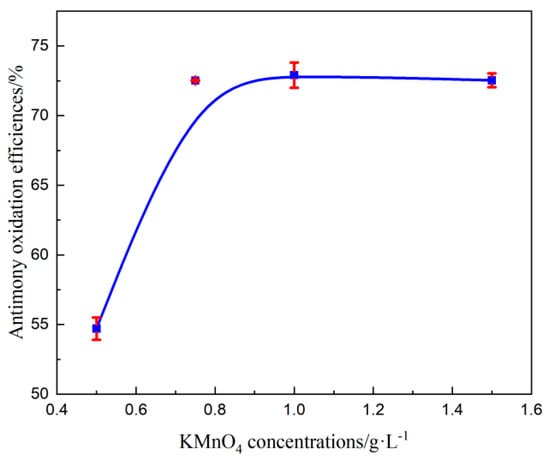
Figure 3.
Effect of KMnO4 concentrations on the oxidation efficiency of antimony at the NaOH concentration of 40 g·L−1 and catechol concentration of 0.5 g·L−1, under the air flow rate of 0.708 m3·min−1, at 55 °C for 10 h.
Effect of Catechol Concentration
The effect of catechol concentrations on the oxidation efficiency of antimony at the NaOH concentration of 40 g·L−1 and KMnO4 concentration of 0.75 g·L−1, under the air flow rate of 0.708 m3·min−1, at 55 °C for 10 h was investigated; the results are shown in Figure 4. The oxidation of antimony first increases and subsequently becomes stable to 97% with an increase in the catechol concentration. However, as soon as the catechol concentration exceeds 0.75 g·L−1, the colour of the precipitate deepens from white to grey-black, affecting product purity. The results indicate that when the catechol concentration was 0.75 g·L−1, a significant effect was observed on the oxidation efficiency of antimony.
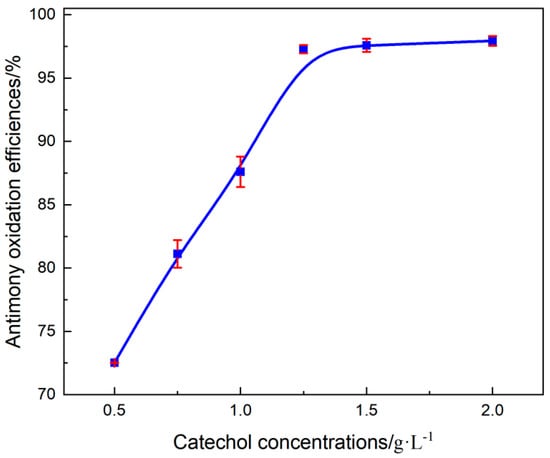
Figure 4.
Effect of catechol concentrations on the oxidation efficiency of antimony at the NaOH concentration of 40 g·L−1 and KMnO4 concentration of 0.75 g·L−1, under the air flow rate of 0.708 m3·min−1 at 55 °C for 10 h.
3.3.3. Effect of Air Flow Rate
The effect of the air flow rates on the oxidation efficiency of antimony at the NaOH concentration of 40 g·L−1, KMnO4 concentration of 0.75 g·L−1, catechol concentration of 0.75 g·L−1 and at 55 °C for 10 h, was investigated; the results are shown in Figure 5. The increase in the air flow rate increases the oxidation efficiency of antimony to 98%, which remained unaffected at 1.415 m3·min−1. At this rate, the solubility of O2 in the solution had reached a saturated state. An increase in the air flow rate had a negligible effect on antimony oxidation efficiency, but such an increase allows considerable heat loss and increases energy consumption. The results indicate that an air flow rate of 1.415 m3·min−1 had a significant effect on the oxidation efficiency of antimony.
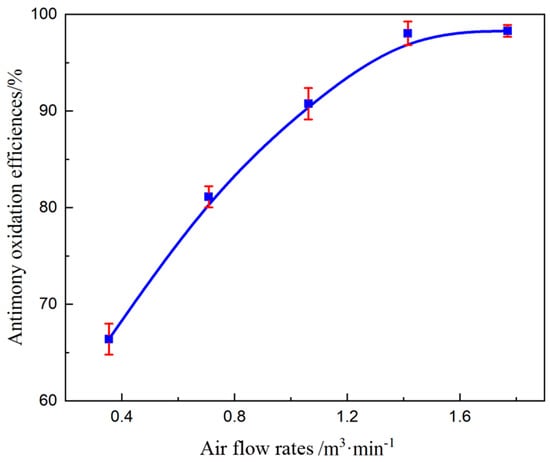
Figure 5.
Effect of the air flow rates on the antimony oxidation efficiency at the NaOH concentration of 40 g·L−1, KMnO4 concentration of 0.75 g·L−1, catechol concentration of 0.75 g·L−1 and at 55 °C for 10 h.
3.3.4. Effect of Reaction Temperature
The effect of reaction temperatures on antimony oxidation efficiency at the NaOH concentration of 40 g·L−1, KMnO4 concentration of 0.75 g·L−1, and catechol concentration of 0.75 g·L−1, under the air flow rates of 1.415 m3·min−1 for 10 h, was investigated; the results are shown in Figure 6. The oxidation efficiency of antimony initially increases with increasing reaction temperature, but with further increase, no changes were observed. When the temperature exceeds 75 °C, the oxidation efficiency of antimony was maintained at ~99%. Increasing the reaction temperature increases the reaction efficiency while decreasing the solubility of O2 in the solution; this results in a decrease in the O2 concentration and a decrease in the reaction rate []. The results indicate that the reaction temperature was selected to be 75 °C.
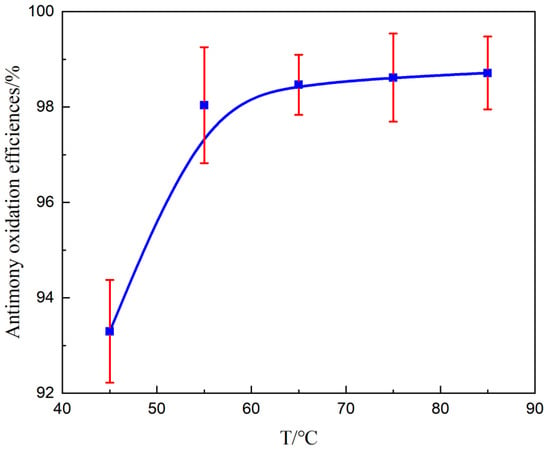
Figure 6.
Effect of reaction temperatures on the antimony oxidation efficiency at the NaOH concentration of 40 g·L−1, KMnO4 concentration of 0.75 g·L−1, and catechol concentration of 0.75 g·L−1, under the air flow rates of 1.415 m3·min−1 for 10 h.
3.3.5. Effect of NaOH Concentration
The effect of the NaOH concentration on the oxidation efficiency of antimony at the KMnO4 concentration of 0.75 g·L−1 and catechol concentration of 0.75 g·L−1, under the air flow rates of 1.415 m3·min−1 at 75 °C for 10 h, was investigated; the results are shown in Figure 7. Increasing the NaOH concentration increases the oxidation efficiency of antimony. However, when the NaOH concentration exceeds 50 g·L−1, the oxidation efficiency of antimony does not change much and remains at ~99%. The results indicate that at the NaOH concentration 50 g·L−1, a significant effect on the oxidation efficiency of antimony was observed.
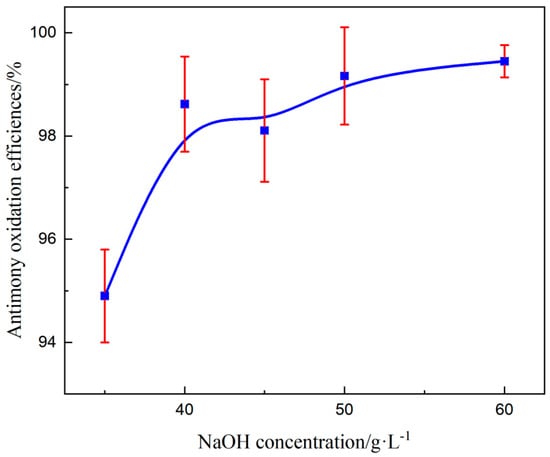
Figure 7.
Effect of the NaOH concentration on the oxidation efficiency of antimony at the KMnO4 concentration of 0.75 g·L−1 and catechol concentration of 0.75 g·L−1, under the air flow rates of 1.415 m3·min−1 at 75 °C for 10 h.
3.3.6. Effect of Reaction Time
The effect of the reaction time on the oxidation efficiency of antimony at the NaOH concentration of 50 g·L−1, KMnO4 concentration of 0.75 g·L−1, catechol concentration of 0.75 g·L−1, and under the air flow rates of 1.415 m3·min−1 at 75 °C, was investigated; the results are shown in Figure 8. With the increase in reaction time, the oxidation efficiency of antimony increases rapidly at first and then remains unchanged. However, the reaction reached the equilibrium when the reaction time was ~8 h, at which the oxidation efficiency of antimony reached >98%. The results indicate that the optimal reaction time was selected to be 8 h.
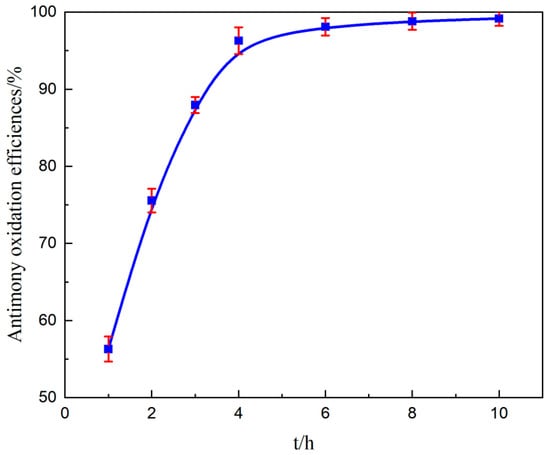
Figure 8.
Effect of the reaction time on the antimony oxidation efficiency at the NaOH concentration of 50 g·L−1, KMnO4 concentration of 0.75 g·L−1, catechol concentration of 0.75 g·L−1 under the air flow rates of 1.415 m3·min−1 at 75 °C.
The solution contains arsenic and other impurities after the precipitation of antimony, which can be removed by precipitation using calcium salt.
3.4. Crude Sodium Antimonate Purification
A crude sodium antimonate product was formed by the reaction at the NaOH concentration of 50 g·L−1, KMnO4 concentration of 0.75 g·L−1, catechol concentration of 0.75 g·L−1 and under the air flow rates of air flow rate of 1.415 m3·min−1 at 75 °C for 8 h. Its composition and industry standard values [] are summarised in Table 4.

Table 4.
Composition of crude sodium antimonate product and industry standard.
It can be seen from Table 4 that the content of Sb2O5 of the product was lower than that of the standard. Moreover, the content of impurity elements arsenic and lead exceeded that of the standard, while the rest of the elements had equivalent values. In order to prepare products that meet the industry standards, crude sodium antimonate products need to be redissolved in hydrochloric acid to remove the impurities and recrystallised to prepare high-quality products.
Concentrated hydrochloric acid was used to dissolve crude sodium antimonate and heated to 70 °C, the pH was adjusted between 1 and 2 after filtration, and the filtrate was neutralised with the NaOH solution by adjusting the pH between 12 and 14 at room temperature. The resultant filtrate was reacted for 30 min to prepare antimonic acid after filtering the sodium products. The chemical composition was analysed post drying; the results are summarised in Table 5. The results indicate that the antimony recovery rate can reach more than 95.60%.

Table 5.
Composition of the refined sodium antimonate product with the industry standard.
It can be seen from Table 5 that the refined sodium antimonate product meets the secondary product standards of China’s non-ferrous metal industry (YS 22-2010). The SEM image of sodium antimonate in Figure 9 shows that the product particles were granular, and had irregular crystals with uniform particle size distribution and good dispersion; however, no obvious agglomeration was observed.
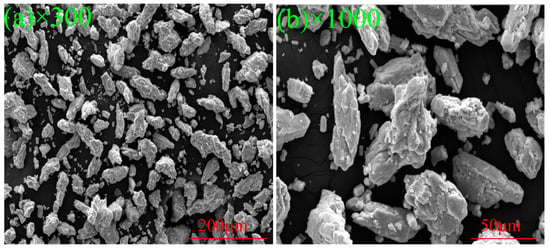
Figure 9.
SEM images of the refined sodium antimonate product.
3.5. Kinetic Analysis
Equation (2) shows that the oxidation process is a multiphase process involving a gas–liquid phase, and the reaction includes the following steps:
- (1)
- The gaseous reactant, oxygen, diffuses from the gas phase to the gas–liquid phase interface.
- (2)
- Oxygen diffuses into the liquid phase from the gas–liquid phase interface and reacts in the liquid phase.
- (3)
- The reactants diffuse from the liquid phase to the gas–liquid reaction interface; and react with dissolved oxygen during the diffusion process.
- (4)
- The resulting product diffuses into the bulk of the liquid phase.
The kinetic equation for reaction (2) is expressed as
where k is the reaction rate constant, and α, β, γ, and δ represent the order of the corresponding reactants 1, 2, 3, and 4, respectively. Among them, the concentration of H2O in the solution was constant, and the solubility of O2 in the solution system obeys Henry’s law. When the pressure of the reaction system is the standard atmospheric pressure, the Henry coefficient of air in the solution at different temperatures is summarised in Table 6 [].

Table 6.
Henry coefficient of air in water.
According to Henry’s law, the O2 concentration in the solution can be regarded as a constant, as seen in Table 2, within the temperature range of 55–85 °C, provided the air flow rate is held constant, and the Henry’s coefficient does not change considerably. Therefore, the oxidation efficiency of antimony can be considered to be only related to the [Sb] and [NaOH] concentrations in the solution; Equation (12) can be simplified as
In Equation (13), if the reactant concentrations are equal, the n-order reaction rate can be simplified as
Equation (14) can be obtained after integrating Equation (13)
where is plotted against t, and is substituted into Equation (15). The half-life of the reaction can be calculated as t1/2 using Equation (16):
Equation (16) can be obtained by taking the logarithm of Equation (17):
where .
According to Equation (16), reaction coefficient n and rate coefficient kA can be calculated from the slope and intercept of the straight line.
Since it was difficult to measure t1/2 during the experiment, CA was plotted against t, and different initial concentrations of CA0 were selected from the curve to obtain the corresponding half-life; subsequently, reaction coefficient n and rate coefficient kA were obtained by plotting the pair.
Since the oxidation reaction rate of antimony was related to the concentrations of antimony and NaOH, the isolation method was used, and the reaction rate was calculated using Equation (18):
The isolation method can be used to obtain the values of reaction orders α and β.
First, the initial reaction concentration was set to CB ≫ CA; next, CB was considered approximately constant because the value remained unchanged during the reaction process. Equation (18) can be expressed as
The reaction rate was related to CA, and and α were obtained using the half-life method. Under the condition that CA0 remains unchanged, CB0 was changed to make , and substituted in Equation (18):
After taking the logarithm, we obtain
where V1 and V2 are the instantaneous reaction rates at the corresponding time points of the two experiments.
Therefore, by changing the conditions of different CB0 to conduct experiments, the β value was obtained using Equation (19). Finally, reaction rate k was obtained according to the formula, .
According to the Arrhenius formula, was plotted to obtain reaction activation energy .
3.5.1. Half-Life Method
Different reaction temperatures were controlled and intermittent sampling was performed to analyse the concentration of antimony in the solution at the NaOH concentration of 250 g·L−1, KMnO4 concentration of 0.75 g·L−1, catechol concentration of 0.75 g·L−1, and under the air flow rates of 1.415 m3·min−1; the results are shown in Figure 10.
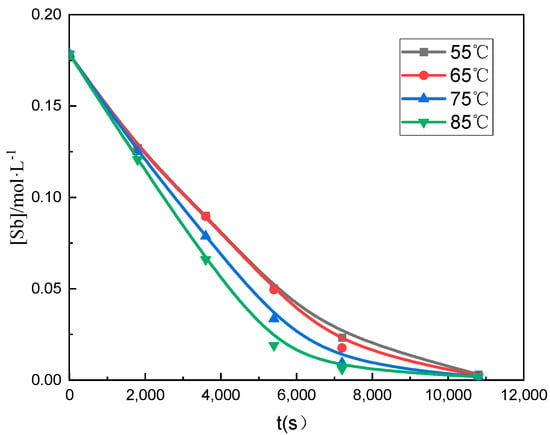
Figure 10.
Relationship between the concentration of antimony and reaction time at different reaction temperatures.
The results in Figure 10 indicate half-life t1/2 at the initial concentrations of antimony in reactants [Sb]0 with 0.16, 0.14, 0.12, 0.10, 0.08, and 0.06 mol·L−1. The plot of lg t1/2 - lg [Sb]0 was fitted; the result is shown in Figure 11.
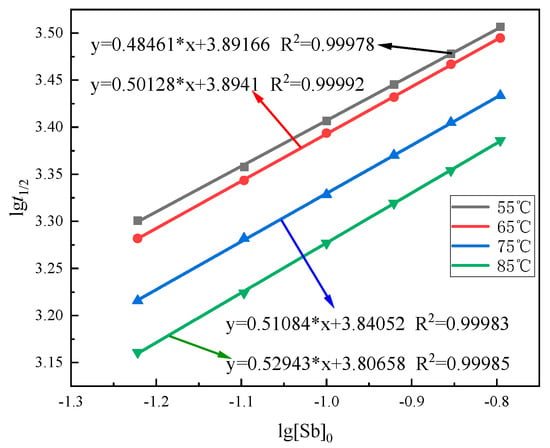
Figure 11.
Relationship between lg [Sb]0 and lg t1/2 at different reaction temperatures.
According to the slopes and intercepts of the curves at different temperatures in Figure 11, n and k can be calculated; the results are summarised in Table 7.

Table 7.
Antimony oxidation reaction rates at antimony concentration series n and k at different temperatures.
3.5.2. Isolation Method
The concentration of antimony in the solution was analysed by intermittent sampling at the NaOH concentration of 300 g·L−1, KMnO4 concentration of 0.75 g·L−1, catechol concentration of 0.75 g·L−1, under the air flow rates of 1.415 m3·min−1 at 85 °C; the results are shown in Figure 12.
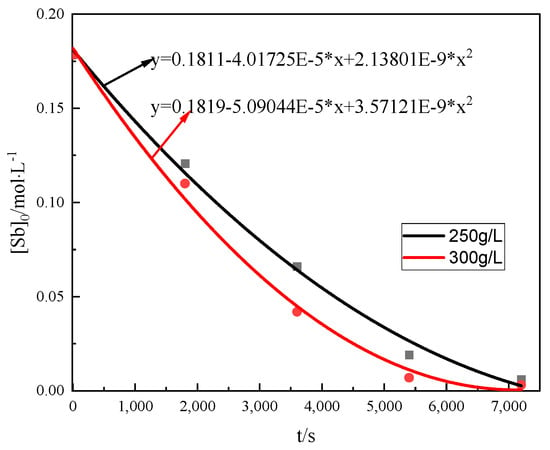
Figure 12.
Relationship between concentration of antimony and reaction times in solution at different NaOH concentrations.
The reaction times required to achieve different [Sb] were calculated from the curve of equation in Figure 11; the values are summarised in Table 8.

Table 8.
Reaction schedule for reaching different [Sb] at different NaOH concentrations.
Subsequently, an equation was derived to obtain the reaction efficiency at different concentrations. Additionally, β at different concentrations can be obtained using Equation (18) (where n = 300/250 = 1.2), as shown in Table 9.

Table 9.
Reaction rates and reaction orders at different [Sb].
The results in Table 8 indicate that the average value of β was 1.190. The oxidation reaction rate of antimony at different reaction temperatures can be calculated from reaction rate k, calculated by the half-life method (shown in Table 7), that is, k = . The results are shown in Table 10.

Table 10.
Oxidation reaction rate coefficient k of antimony at different temperatures.
Therefore, the kinetic equation for the reaction rate of antimony oxidation is
3.5.3. Reaction Activation Energy
According to the values of the reaction rate coefficient at each temperature given in Table 9, ln k was plotted with ; the result is shown in Figure 13.
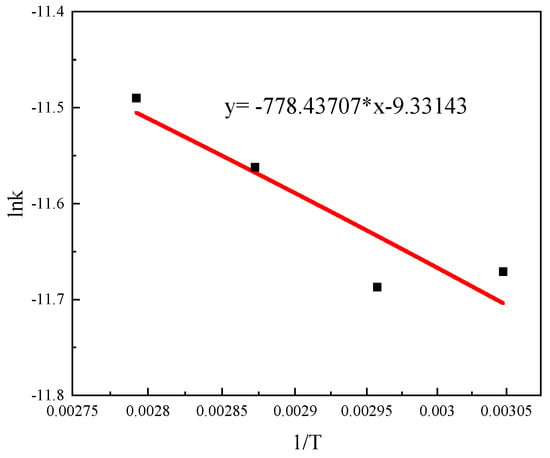
Figure 13.
Relationship between ln k and 1/T.
Figure 13 shows that the slope of the straight line was −606.54964; therefore, apparent activation energy Ea of the oxidation reaction can be calculated using the following formula:
The value of Ea of the oxidation reaction was calculated to be 6.47 kJ·mol−1, indicating that the reaction process was controlled by diffusion. The reaction rate equation was , and the reaction kinetics equation was .
4. Conclusions
- (1)
- In the first compound leaching stage, a leaching efficiency of 94% was achieved for antimony, while elements such as copper, lead, silver, and bismuth had leaching efficiencies of <3%. The results indicated that the enrichment of copper, lead, silver, and bismuth was approximately 290%, 290%, 280%, and 270%, respectively. The compound leaching slag can be returned to the copper anode slime smelting system for further recovery.
- (2)
- The oxidation rate of antimony reached more than 98% at the NaOH concentration of 50 g·L−1, KMnO4 concentration of 0.75 g·L−1, catechol concentration of 0.75 g·L−1 and under the air flow rates of 1.415 m3·min−1 at 75 °C for 8 h, and crude sodium antimonate products were formed.
- (3)
- After the crude sodium antimonate product was redissolved and adjusted to pH 12–14, refined sodium antimonate with uniform particle size distribution, good dispersibility, which met the second-class standard of the non-ferrous metal industry. The recovery rate of antimony was found to be >95.60%, and the liquid after neutralisation contained [As] < 0.10 g·L−1, [Sb] = 0.16-0.38 g·L−1, which can be reused in the composite leaching process.
- (4)
- The apparent activation energy (Ea) of the oxidation reaction was 6.47 kJ·mol−1, and the reaction process was diffusion controlled. The reaction rate equation was , and the reaction kinetics equation was .
Author Contributions
Conceptualization, Y.Z., J.J., C.L. and F.L.; data curation, Y.Z., J.J. and C.L.; formal analysis, Y.Z., J.J., C.L. and F.L.; investigation, Y.Z., J.J. and C.L.; methodology, Y.Z., J.J. and C.L.; project administration, Y.Z. and C.L.; resources, Y.Z., C.L. and F.L.; software, Y.Z.; supervision, Y.Z., J.J., C.L. and F.L.; validation, Y.Z., J.J., C.L. and F.L.; writing—original draft, Y.Z.; writing—review and editing, Y.Z. and F.L. All authors have read and agreed to the published version of the manuscript.
Funding
This paper has been financially supported by the National Key Research and Development Program of China: 2023YFC2907902; National Nature Science Foundation of China (No. 52264047), Natural Science Foundation for Distinguished Young Scholars of Jiangxi Province (No. 20232ACB214006), Scientific Research Startup Project for High-Level Talents of Jiangxi University of Science and Technology (205200100794), Ganpo Talent Youth Innovation High end Talent Project (gpyc20240066).
Data Availability Statement
The original contributions presented in this study are included in the article. Further inquiries can be directed to the corresponding authors.
Conflicts of Interest
Author Chunfa Liao was employed by the company Shandong Zhongjin Lingnan Copper Co., Ltd. The remaining authors declare that the research was conducted in the absence of any commercial or financial relationships that could be construed as a potential conflict of interest.
References
- Tang, Z.L.; Tang, X.C.; Xiao, Z.Y.; Liu, H.N. A novel approach to synthesizing sodium antimonate and recovering lead and zinc from arsenic—Bearing antimony white. Miner. Eng. 2023, 192, 108008. [Google Scholar] [CrossRef]
- Yang, T.; Tang, J.; Bing, W.; Liu, C. Review of the preparation of sodium pyroantimonate. Inorg. Chem. Ind. 1999, 31, 22–24. [Google Scholar]
- Yi, Y.; Shi, J.; Tian, Q.H.; Guo, X.Y. Novel technology for preparation of sodium pyroantimonate from alkali leaching residue of high arsenic dust. Chin. J. Nonferrous Met. 2015, 25, 241–249. [Google Scholar] [CrossRef]
- Liang, Y.; Zhong, N. Process for producing sodium antimonate by chlorination. Inorg. Chem. Inoustry 1991, 1, 14–18. [Google Scholar]
- Du, X. Research on the Production Technology of Sodium Pyroantimonite. Hunan Nonferrous Met. 2008, 24, 24–26. [Google Scholar] [CrossRef]
- Zhang, B.; Li, Q.; Shen, W.; Min, X. Recovery of bismuth and antimony metals from pressure-leaching slag. Rare Met. 2012, 31, 102–106. [Google Scholar] [CrossRef]
- Cui, P.; Shen, Q.; Yu, X.; Yang, F.; Xie, G.; Jin, Y.; Jin, G. Experimental Study on Preparation of Sodium Antimonate from Tetrahedrite Alkaline System. Nonferrous Met. Engincering 2022, 12, 80–87+99. [Google Scholar] [CrossRef]
- Liu, W.; Jiao, A.; Liu, L.; Zhang, D.; Chen, L.; Yang, T. Clean technologies for producing sodium pyroantimonate by pressure oxidation method. Chin. J. Nonferrous Met. 2020, 30, 2379–2387. [Google Scholar] [CrossRef]
- Gu, K.; Liu, W.; Han, J.; Ou, Z.; Wu, D.; Qin, W. Arsenic and antimony extraction from high arsenic smelter ash with alkaline pressure oxidative leaching followed by Na2S leaching. Sep. Purif. Technol. 2019, 222, 53–59. [Google Scholar] [CrossRef]
- Zeng, O.; Zhao, R.; Guan, X. Study on Preparation of Sodium Antimonate by Oxidative Reflux Method. Inorg. Chem. Inoustry 1991, 1, 11–13. [Google Scholar]
- Feng, X. Production of sodium pyroantimonate by double decomposition. Guizhou Chem. Ind. 2000, 1, 22–23. [Google Scholar]
- Liu, W.; Zhang, K.; Zhang, D.; Chen, L.; Liu, L.; Yang, T. Preparation of Sodium Pyroantimonate from Antimony Trioxide by Pressure Oxidation in NaOH Solution. JOM 2019, 71, 3688–3695. [Google Scholar] [CrossRef]
- Liu, Q.; Shan, T.; Jin, C. Study of preparation of sodium antimonate from antimony oxidized ore with alkaline process. Hunan Nonferrous Met. 2014, 30, 31–33. [Google Scholar] [CrossRef]
- Awe, S.A.; Sandstrom, A. Selective leaching of arsenic and antimony from a tetrahedrite rich complex sulphide concentrate using alkaline sulphide solution. Miner. Eng. 2010, 15, 1227–1236. [Google Scholar] [CrossRef]
- Wang, Z.; Yang, T.; Wang, W. Trial production of sodium pyroantimonate from antimony concentrate. Hunan Metall. 2005, 33, 17–20. [Google Scholar] [CrossRef]
- Xue, M.; Qian, F.; Zhang, Z.; Mo, Y.; Cao, J.; Pei, R. Method for Preparing Sodium Pyroantimonate Using Plant Polyphenols as Catalyst for Catalytic Air Oxidation. ZL20181038 1108.8, 2018.
- Zhang, L.; Guo, X.; Tian, Q.; Qin, H. Selective removal of arsenic from high arsenic dust in the NaOH-S system and leaching behavior of lead, antimony, zinc and tin. Hydrometallurgy 2021, 202, 105607. [Google Scholar] [CrossRef]
- Liao, C.; Zeng, Y.; Jin, J.; Jiang, P.; Lai, J. The Mechanism Research of Antimony Leaching from Copper Anode Slime Points Antimony Enrichment. Nonferrous Met. Eng. 2017, 7, 34–38. [Google Scholar] [CrossRef]
- Fu, B. Metallurgical Analysis of Modern Heavy Metals; Chemical Industry Press: Beijing, China, 2007; pp. 298–299. [Google Scholar]
- Chen, M.; Cong, D.Z.; Fang, T.N. Principles of Chemical Engineering, 3rd ed.; Chemical Industry Press: Beijing, China, 2006. [Google Scholar]
- Zhao, X. Chemical Reaction Kinetic Principles; Higher Education Press: Beijing, China, 1984; Volume 1, pp. 16–17. [Google Scholar]
- YS/T 22-2010; Sodium Antimonate. National Nonferrous Metals Standardization Technical Committee: Beijing, China, 2010.
Disclaimer/Publisher’s Note: The statements, opinions and data contained in all publications are solely those of the individual author(s) and contributor(s) and not of MDPI and/or the editor(s). MDPI and/or the editor(s) disclaim responsibility for any injury to people or property resulting from any ideas, methods, instructions or products referred to in the content. |
© 2025 by the authors. Licensee MDPI, Basel, Switzerland. This article is an open access article distributed under the terms and conditions of the Creative Commons Attribution (CC BY) license (https://creativecommons.org/licenses/by/4.0/).